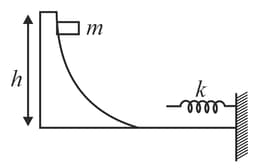MEDIUM
JEE Main/Advance
IMPORTANT
Earn 100
A particle falls from rest under gravity. Its potential energy with respect to ground and its kinetic energy are plotted with time . Choose the correct graph.
50% studentsanswered this correctly
Important Questions on Work, Energy and Power
EASY
JEE Main/Advance
IMPORTANT
Consider the spring block system shown in the figure initially block is in equilibrium. An impulse gives the block a velocity upwards. Find the maximum speed of the block during the motion.

MEDIUM
JEE Main/Advance
IMPORTANT
A block of mass is released from a height from the top of a smooth surface. There is an ideal spring of spring constant at the bottom of the track. Find the maximum compression in the spring. (Wedge is fixed)

EASY
JEE Main/Advance
IMPORTANT
MEDIUM
JEE Main/Advance
IMPORTANT
MEDIUM
JEE Main/Advance
IMPORTANT
MEDIUM
JEE Main/Advance
IMPORTANT
MEDIUM
JEE Main/Advance
IMPORTANT
MEDIUM
JEE Main/Advance
IMPORTANT
